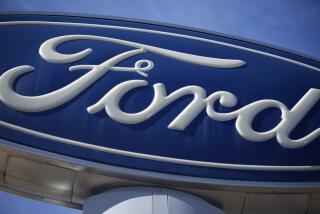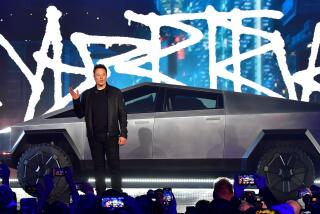Ford’s new F-150: America’s favorite pickup goes hybrid (in more ways than one)
- Share via
The Ford F-150 pickup is the top-selling vehicle in America — not just the No. 1 truck; it’s the No. 1 vehicle, period — and has been for the last 43 years running. Last year, Henry Ford’s legacy company sold nearly 900,000 of the things, 36% of all U.S. truck sales, leaving Chevrolet, Ram, GMC, Toyota, Honda, Nissan and all the other truck makers in its dust.
But Ford’s once-comfortable lead on its competitors is narrowing. Over the last several years, Chevy sales have remained steady. Ram sales have risen. Ford’s have not.
Now, in a bold move, Ford has dramatically overhauled its F-150 for 2021. Its new workhorse vehicle is a revolutionary step forward in design and technology, likely to dramatically increase F-150 sales for the next few years.
Ford executives say the redesign’s inspiration came from the grass roots: Changes to the truck — including its chassis, body, engine and interior — reflect consumer needs, requests and complaints.
The result is a machine that is as much workstation as transportation device, a clever attempt to combine truck, mobile office and field workshop into a single unit. In that, it’s almost revolutionary.
“From top to bottom, throughout the truck, with the functional and effective improvements, this is as sweeping as any truck design I’ve ever seen,” said industry veteran Karl Brauer, analyst for the automotive search engine ISeeCars.com, who test-drove the truck the same day I did, in mid-November.
Foremost among many changes is the option of a full hybrid engine, the first ever offered in a full-size pickup truck. Available in all models, from the lowly XL (starting MSRP $28,940) to the mighty Limited (starting MSRP $70,825), each of the F-150s can be had with the new PowerBoost powerplant, a six-cylinder, twin-turbo, 3.5-liter gasoline and electric combination that produces a staggering 430 horsepower and 570 pound-feet of torque. The upgrade starts as low as $1,900.
The F-150s can all also be purchased with five other engines, from the economical 2.7-liter EcoBoost V-6 to a 5-liter V-8 and a 3-liter V-6 turbo diesel. They and the PowerBoost are all mated to a 10-speed automatic transmission. All models are available in four-wheel-drive configurations too.
The driving modes that put this power to the ground are user friendly, presented with simple names such as “Normal,” “Slippery” or “Mud/Ruts” and accompanied by animations on the nicely configured dashboard to show exactly what those conditions look like. The Rock Crawl mode shows a truck on a slope of sharp stones; in Slippery mode, there are animated raindrops falling; and the Sport mode appears to show the truck on an actual racetrack.
The adaptive cruise control and lane centering functions are top-notch. On the freeway, the F-150 in that mode almost drives itself — slowing, braking and speeding up smoothly with no driver input.
The PowerBoost engine means better gas mileage, a reported 24 miles per gallon in the city and on the highway, but it also provides massive towing power and impressive off-road capability. (I tried hauling a powerboat up and down the Interstate 5 Grapevine a few times, and then spinning the tires and slinging sand while hill-climbing the back roads of the Grapevine-area Tejon Ranch).
But Ford has done more with the electric motor than use it simply to boost torque. Because “hybrid” means an onboard electric motor, and an onboard battery for electric storage, the new F-150 designers have used that power to transform their new truck into what the company calls the most “productive” vehicle it has ever built.
With the hybrid setup acting like a generator, it features a tailgate work area with enough plug-ins to run a Skil saw, recharge a whole workshop full of cordless power tools and even, Ford says, run an arc welder. (Ford promotional materials also indicate the power can be used to run a music system and big screen TV, so … party on.)
The tailgate area also features newly designed places to apply clamps to hold down work without wrecking the paint, along with generous in-bed lighting for working at night and an impressive number of tie-down points for securing a load. (As a motorcycle-hauling guy, I appreciate this.) There are also exterior lights that can be manipulated with dashboard buttons or a smartphone to illuminate specific work areas outside the truck.
The inside of the truck has gotten more user-friendly, as well. The front seats fold almost entirely flat. The gear selector folds flat too, allowing the center console to extend into a broad workspace for the operator’s laptop, notebook, clipboard and more. There are slots where you can prop up your phone or tablet, in the center console and on the tailgate, so you can watch the YouTube video called “How to Cut Wood” while actually cutting wood.
The F-150’s designers have also included a sensible storage system that makes it possible to stow and lock a fair amount of equipment under the rear seats — essential for working folks who need a place to put those power tools — while retaining enough room to include a tire jack and set of tire irons. Every F-150, admirably, also comes with a full-size spare — an increasing rarity on new vehicles.
Trucks have been becoming more like cars for years and now include as many technical and luxury appointments as equivalently priced cars. As a consequence, truck sales overall have been rising, while car sales have fallen. In April, for the first time, trucks outsold cars — leaving SUVs out of the equation — by a narrow margin.
But who are these truck buyers, you may ask. People who actually use the vehicles as intended, or posers who wear their trucks like some folks wear a trucker hat?
The former, mostly. More than 80% of owners use their trucks at least once a year for hauling something, and at least 50% use them for towing something, according to data compiled by the research firm Strategic Vision.
“Most truck people buy a truck because there’s a reason for it,” Strategic Vision President Alexander Edwards said. “But they also see the truck as a part of their image, as part of who and what they’re about.”
Was I impressed? Yes. Am I prejudiced? Maybe a bit. Though my very first car was a 1951 Chevy panel truck, I currently have a 2007 Ford Ranger parked in my driveway. It replaced a 1997 Ford Ranger.
Ford is hedging its bet a little. A conventional truck buyer, perhaps suspicious of new technology, can still choose an F-150 with an old-fashioned diesel or V-8 engine. But Brauer said the prospective F-150 owner might not be as resistant to a hybrid truck as American buyers in general have been to hybrid and plug-in hybrid cars, which still make up a slim segment of overall sales. That truck customer will be paying close attention to the truck’s power specs.
“This is a group of buyers that understands what the terms ‘horsepower’ and ‘torque’ mean,” Brauer said. “And these are really impressive numbers.”
By leaning further toward alternative powertrains, Ford is also yielding to reality. The move away from internal combustion engines to electric motors, for all new vehicles, is no longer theoretical. Many European countries have already set dates after which no new internal combustion engine vehicles can be sold. For California, that day is coming in 2035. And Ford, after all, was the only American brand that didn’t abandon California’s strict fuel economy targets when the Trump administration encouraged U.S. automakers to start relaxing previously set requirements. (To be fair, GM eventually followed, and Nissan announced in early December that it would cleave to California standards.)
Besides, the electric pressure is on. California carmaker Tesla says it will bring an all-electric truck to market soon. The boutique companies Rivian and Bollinger already offer all-electric pickups. And Ford itself has already begun building and testing an all-electric F-150, which it could bring to market by mid-2022, along with a small utility van.
So maybe the hybrid F-150 will soften the market for the arrival of a fully electrified Ford pickup. But that’s only if — and it’s a big if — the truck delivers.
As long as Ford’s first-year F-150 hybrid technology works as advertised, it may solve more problems than some buyers are even aware they have. I’m not shopping to replace my dependable old Ranger, but if I were, this pickup would be at the top of my list.
2021 Ford F-150 with PowerBoost engine
More to Read
Inside the business of entertainment
The Wide Shot brings you news, analysis and insights on everything from streaming wars to production — and what it all means for the future.
You may occasionally receive promotional content from the Los Angeles Times.











